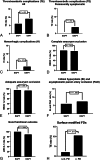Prasugrel Single Antiplatelet Therapy versus Aspirin and Clopidogrel Dual Antiplatelet Therapy for Flow Diverter Treatment for Cerebral Aneurysms: A Retrospective Multicenter Study
- PMID: 38453414
- PMCID: PMC11288545
- DOI: 10.3174/ajnr.A8163
Prasugrel Single Antiplatelet Therapy versus Aspirin and Clopidogrel Dual Antiplatelet Therapy for Flow Diverter Treatment for Cerebral Aneurysms: A Retrospective Multicenter Study
Abstract
Background and purpose: The optimal antiplatelet regimen after flow diverter treatment of cerebral aneurysms is still a matter of debate. A single antiplatelet therapy might be advantageous in determined clinical scenarios. This study evaluated the efficacy and safety of prasugrel single antiplatelet therapy versus aspirin and clopidogrel dual antiplatelet therapy.
Materials and methods: We performed a post hoc analysis of 4 retrospective multicenter studies including ruptured and unruptured aneurysms treated with flow diversion using either prasugrel single antiplatelet therapy or dual antiplatelet therapy. Primary end points were the occurrence of any kind of procedure- or device-related thromboembolic complications and complete aneurysm occlusion at the latest radiologic follow-up (mean, 18 months). Dichotomized comparisons of outcomes were performed between single antiplatelet therapy and dual antiplatelet therapy. Additionally, the influence of various patient- and aneurysm-related variables on the occurrence of thromboembolic complications was investigated using multivariable backward logistic regression.
Results: A total of 222 patients with 251 aneurysms were included, 90 (40.5%) in the single antiplatelet therapy and 132 (59.5%) in the dual antiplatelet therapy group. The primary outcome-procedure- or device-related thromboembolic complications-occurred in 6 patients (6.6%) of the single antiplatelet therapy and in 12 patients (9.0%) of the dual antiplatelet therapy group (P = .62; OR, 0.712; 95% CI, 0.260-1.930). The primary treatment efficacy end point was reached in 82 patients (80.4%) of the single antiplatelet therapy and in 115 patients (78.2%) of the dual antiplatelet therapy group (P = .752; OR, 1.141; 95% CI, 0.599-2.101). Logistic regression showed that non-surface-modified flow diverters (P = .014) and fusiform aneurysm morphology (P = .004) significantly increased the probability of thromboembolic complications.
Conclusions: Prasugrel single antiplatelet therapy after flow diverter treatment may be as safe and effective as dual antiplatelet therapy and could, therefore, be a valid alternative in selected patients. Further prospective comparative studies are required to validate our findings.
© 2024 by American Journal of Neuroradiology.
Figures

Similar articles
-
Prasugrel versus clopidogrel in stent-assisted coil embolization of unruptured intracranial aneurysms.Interv Neuroradiol. 2017 Feb;23(1):52-59. doi: 10.1177/1591019916669090. Epub 2016 Oct 22. Interv Neuroradiol. 2017. PMID: 27760885 Free PMC article.
-
Efficacy and Safety of Dual Antiplatelet Therapy with the Routine Use of Prasugrel for Flow Diversion of Cerebral Unruptured Aneurysms.Clin Neuroradiol. 2024 Mar;34(1):201-208. doi: 10.1007/s00062-023-01355-2. Epub 2023 Oct 17. Clin Neuroradiol. 2024. PMID: 37847296 Free PMC article.
-
Safety and efficacy of dual antiplatelet therapy combining aspirin and ticagrelor in patients with undergoing intracranial stenting procedures.J Neurosurg Sci. 2024 Oct;68(5):598-603. doi: 10.23736/S0390-5616.22.05745-9. Epub 2022 Sep 16. J Neurosurg Sci. 2024. PMID: 36112120
-
Outcome of intracranial flow diversion according to the antiplatelet regimen used: a systematic review and meta-analysis.J Neurointerv Surg. 2020 Feb;12(2):148-155. doi: 10.1136/neurintsurg-2019-014996. Epub 2019 Jul 4. J Neurointerv Surg. 2020. PMID: 31273075
-
Efficacy and Safety of High Potent P2Y12 Inhibitors Prasugrel and Ticagrelor in Patients With Coronary Heart Disease Treated With Dual Antiplatelet Therapy: A Sex-Specific Systematic Review and Meta-Analysis.J Am Heart Assoc. 2020 Feb 18;9(4):e014457. doi: 10.1161/JAHA.119.014457. Epub 2020 Feb 17. J Am Heart Assoc. 2020. PMID: 32063118 Free PMC article.
Cited by
-
Clinically Silent Microinfarct Incidence and Risk Factors After Treatment of Unruptured Intracranial Aneurysms with Hydrophilic Polymer-Coated Flow Diverters.Clin Neuroradiol. 2025 Feb 14. doi: 10.1007/s00062-025-01497-5. Online ahead of print. Clin Neuroradiol. 2025. PMID: 39953138
-
Fourth-generation Pipeline™ Vantage flow diversion: First reported US experience of safety and feasibility.Interv Neuroradiol. 2024 Dec 5:15910199241301119. doi: 10.1177/15910199241301119. Online ahead of print. Interv Neuroradiol. 2024. PMID: 39635842 Free PMC article.
-
Drill turn technique for enhanced visualization of wide-neck bifurcation aneurysms in Y-stent-assisted coiling with LVIS EVO stents: technical considerations and mid-term results.Neuroradiology. 2025 Jan;67(1):227-234. doi: 10.1007/s00234-024-03447-3. Epub 2024 Sep 5. Neuroradiology. 2025. PMID: 39235600
References
Publication types
MeSH terms
Substances
LinkOut - more resources
Full Text Sources
Medical
